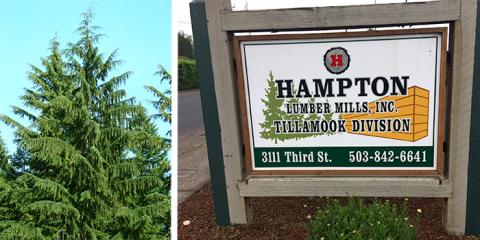Western hemlock: coastal super tree
July 18, 2017
I had the opportunity during last month’s OFRI-sponsored Western Oregon Sustainable Forestry Teacher Tour in Tillamook to visit forestlands managed by Stimson Lumber Co. and the Oregon Department of Forestry as well as tour a Hampton Lumber sawmill. I came away from the tour with the impression that western hemlock is the super tree of the Oregon Coast.
At Stimson Lumber’s Tillamook Tree Farm, we toured a very well-managed forest made up primarily of hemlock with a mixture of western red-cedar, Sitka spruce, Douglas-fir, red alder and big leaf maple. It was clear that western hemlock was the species of choice on the site because the trees responded well to management, grew to a large size in a relatively short time and produced high timber volumes per acre compared to other species.
At Hampton Lumber, we toured a sawmill that handles only western hemlock logs and is well-positioned in the heart of Oregon’s coastal hemlock forests. This dimension lumber mill produces 2-by-4, 2-by-6, 2-by-8, 2-by-10 and 2-by-12s of various lengths, plus some larger, 4-inch-thick boards. It is a modern high-production sawmill with lots of computers and lasers, but with a relatively large number of hands-on employees. The boards coming out of this mill were beautiful. It was interesting to learn that most of the lumber produced there was destined for the pressure-treated lumber market or out to the Midwest to be sold at Menards, a chain of home improvement stores.
At ODF’s Tillamook Forest Center, we learned about management of the Tillamook State Forest and how much of a problem Swiss needle cast is in the forest’s Douglas-fir plantations. This fungal needle disease is causing major losses in tree growth and even some mortality. Western hemlock does not get Swiss needle cast so foresters on the west side of the Coast Range are increasing the number of hemlock they are planting in forests with a mix of tree species. And in coastal forests, they are mostly planting hemlock.
This all reminded me of when I was a forestry student 40 years ago. Back then, we were taught that western hemlock was pretty much a weed and had little value in the market and may not have a place in industrial forestry. Boy, have things changed. Improved management, milling and marketing, along with a major disease problem have changed perceptions of western hemlock among foresters from a weed to a coastal super tree.
For the forest,
Mike Cloughesy
Director of Forestry
